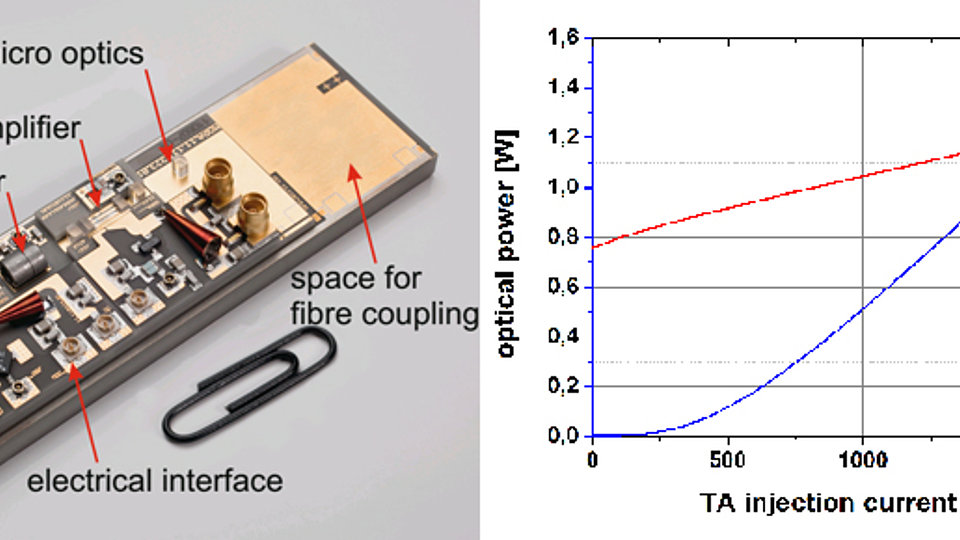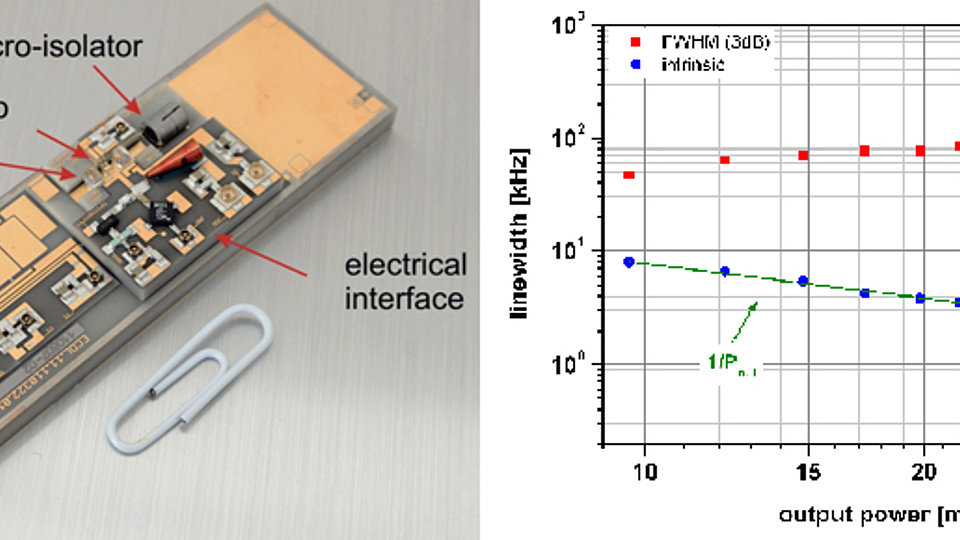Laser sources for atom interferometry in space
For most applications involving cold atom-based quantum sensors such as atom interferometers and optical clocks, a deployment in outer space is highly desirable or even necessary in order to meet the stringent requirements on measurement accuracy and precision. However, until now, one of the main technological limitations is the lack of a space-qualified technology for the lasers that are fundamental to such quantum optics experiments.
At the FBH, we have developed a platform based on GaAs diode lasers that closes this technology gap. The very robust micro-optical benches (MIOB) have a footprint of 80 x 25 mm² and contain no movable parts. The MIOBs are based on AlN and make use of either already space-qualified or space-compatible components and integration technologies. These benches provide an electrical interface that allows the laser diodes to be modulated at UHF frequencies, a feature especially useful for spectroscopy applications. Currently, the MIOBs host hybrid-integrated Master Oscillator Power Amplifiers (MOPA) as shown in Fig. 1 as well as Extended Cavity Diode Lasers (ECDL), see Fig. 2.
The MOPA system carries an energy efficient, single frequency, single spatial mode DFB laser which is optimized for narrow linewidth emission, and achieves an intrinsic linewidth of 35 kHz at 1.4 W (780 nm, Fig. 1). For applications requiring a smaller linewidth we developed ECDLs that achieve an intrinsic linewidth of 2 kHz at 35 mW and 767 nm, as shown in Fig. 2. Due to individual temperature control of the external Bragg grating the ECDL provides fast thermal tuning and can be tuned continuously by more than one spectral range.
Both MOPA and ECDL modules have been successfully vibration tested up to 21 gRMS random noise, and the ECDL has further been subjected to 1500 g pyro-shocks that it passed successfully. These laser sources come into operation on sounding rocked missions FOKUS, MAIUS and KALEXUS as well as in drop tower experiments (PRIMUS) at ZARM, Bremen.
Publications:
H. Müntinga, H. Ahlers, M. Krutzik, A. Wenzlawski, S. Arnold, D. Becker, K. Bongs, H. Dittus, H. Duncker, N. Gaaloul, C. Gherasim, E. Giese, C. Grzeschik, T.W. Hänsch, O. Hellmig, W. Herr, S. Herrmann, E. Kajari, S. Kleinert, C. Lämmerzahl, W. Lewoczko-Adamczyk, J. Malcolm, N. Meyer, R. Nolte, A. Peters, M. Popp, J. Reichel, A. Roura, J. Rudolph, M. Schiemangk, M. Schneider, S.T. Seidel, K. Sengstock, V. Tamma, T. Valenzuela, A. Vogel, R. Walser, T. Wendrich, P. Windpassinger, W. Zeller, T. van Zoest, W. Ertmer, W.P. Schleich, E.M. Rasel, "Interferometry with Bose-Einstein Condensates in Microgravity",
Phys. Rev. Lett., vol. 110, no. 093602 (2013).
E. Luvsandamdin, S. Spießberger, M. Schiemangk, A. Sahm, G. Mura, A. Wicht, A. Peters, G. Erbert, G. Tränkle, "Development of narrow linewidth, micro-integrated extended cavity diode lasers for quantum optics experiments in space", Appl. Phys. B, vol. 111, no. 2, pp. 255-260 (2013).
T.-P. Nguyen, M. Schiemangk, S. Spießberger, H. Wenzel, A. Wicht, A. Peters, G. Erbert, G. Tränkle, V. Kueller, U. Zeimer, M. Weyers, C. Reich, M. Kneissl, "Optimization of 780 nm DFB diode lasers for high-power narrow linewidth emission", Appl. Phys. B, vol. 108, no. 4, pp. 767-771 (2012).
FBH research: 08.09.2014

